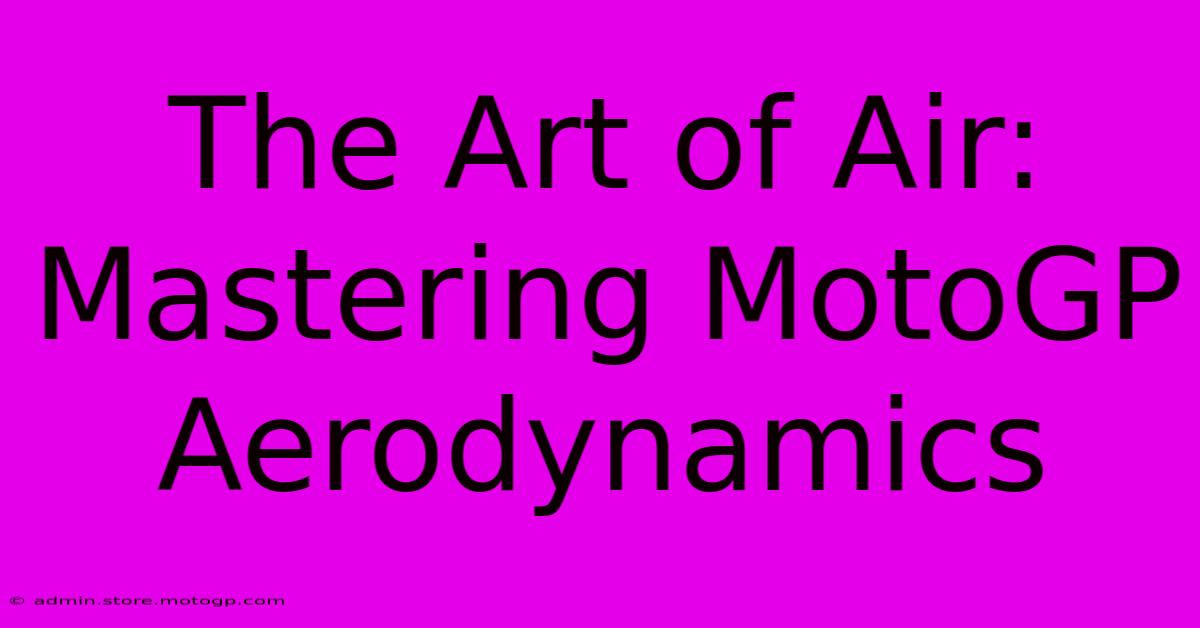The Art Of Air: Mastering MotoGP Aerodynamics

Table of Contents
The Art of Air: Mastering MotoGP Aerodynamics
MotoGP. The pinnacle of motorcycle racing. The roar of the engines, the breathtaking speeds, the nail-biting finishes… it's all captivating. But beyond the raw power and skillful riding, there's a hidden element that plays a crucial role in determining victory: aerodynamics. This isn't just about streamlining; it's a sophisticated science, a battle fought in the slipstream, a war waged with wings and winglets. This article delves into the art of air in MotoGP, exploring how teams harness the power of aerodynamics to gain a crucial edge.
The Importance of Aerodynamic Efficiency in MotoGP
At speeds exceeding 200 mph (320 km/h), even the slightest aerodynamic advantage can translate into significant gains on the track. Aerodynamics isn't simply about reducing drag; it's also about managing downforce. Downforce, the force pushing the bike towards the track, is critical for high-speed cornering. More downforce allows riders to brake later, carry more speed through corners, and ultimately achieve faster lap times.
The Balancing Act: Drag vs. Downforce
The challenge lies in finding the optimal balance between minimizing drag (air resistance slowing the bike) and maximizing downforce. Too much drag hampers top speed, while insufficient downforce compromises stability and cornering ability. Teams constantly strive for the sweet spot – the perfect aerodynamic configuration for each track and riding style.
The Aerodynamic Arsenal: Wings, Winglets, and Fairings
The evolution of MotoGP aerodynamics is a fascinating journey. From simple, streamlined fairings to the complex appendages of today, the technology has advanced dramatically. Let's explore the key components:
Aerodynamic Wings and Winglets:
These aren't just for show; they are meticulously designed to generate downforce. Wings and winglets, often positioned on the front fairing and rear of the bike, use airfoil shapes to create lift (downward in this case) by manipulating airflow. The design, angle, and placement of these elements are constantly refined to optimize performance for different circuits.
The Fairing: More Than Just a Shell
The fairing itself plays a vital role in aerodynamics. Its shape and surface texture are designed to minimize drag and manage airflow around the bike. Computational Fluid Dynamics (CFD) simulations are extensively used to optimize the fairing's design for minimal drag and efficient airflow management. Even small changes in the fairing's design can significantly affect performance.
The Role of Technology in MotoGP Aerodynamics
The pursuit of aerodynamic perfection in MotoGP relies heavily on advanced technology:
Computational Fluid Dynamics (CFD):
CFD simulations allow engineers to virtually test different aerodynamic configurations before ever building a physical prototype. This significantly reduces development time and costs. They can analyze airflow patterns, identify areas of high drag, and optimize designs for maximum downforce.
Wind Tunnel Testing:
Despite the advancements in CFD, wind tunnel testing remains crucial. It provides real-world validation of the CFD simulations and allows engineers to fine-tune the aerodynamic design based on actual airflow data.
The Future of Aerodynamics in MotoGP
The quest for aerodynamic supremacy in MotoGP is far from over. We can expect to see continued innovation and development in this area. The future likely holds even more sophisticated designs, leveraging cutting-edge technologies to push the boundaries of speed and performance.
In conclusion, the art of air in MotoGP is a complex interplay of design, engineering, and testing. The constant pursuit of aerodynamic perfection is a crucial factor in the quest for victory, transforming the race from a simple contest of speed into a sophisticated technological battle. The teams that master the art of air are the ones that often claim the top spot on the podium.

Thank you for visiting our website wich cover about The Art Of Air: Mastering MotoGP Aerodynamics. We hope the information provided has been useful to you. Feel free to contact us if you have any questions or need further assistance. See you next time and dont miss to bookmark.
Featured Posts
-
Aero Advantage Race Bikes For Sale
Feb 20, 2025
-
Moto Gp Race Tracks Creating A More Sustainable Racing Environment
Feb 20, 2025
-
F1 Qualifying Todays Winners And Losers
Feb 20, 2025
-
American Moto Gp The Fight For The Championship
Feb 20, 2025
-
Cota Parking Park Closer Faster With This Map
Feb 20, 2025
